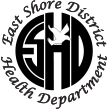BP & Cholesterol Screening
Normal BP is at or below 120/80.
The Top Number or the higher number is the Systolic blood pressure. This is the pressure of blood in the artery when the heart contracts.
The Bottom Number or the lower number is the Diastolic blood pressure. This number refers to the pressure of blood in the artery when the heart relaxes between beats.
Condition |
Systolic Pressure |
Diastolic Pressure |
|
Normal Blood Pressure |
119 or below |
79 or below. |
|
Pre-Hypertensive |
120 to 139 |
80 to 89. |
|
High Blood Pressure |
140 or higher. |
90 or higher. |
People with some medical conditions may have a different target blood pressure. For example, the goal for people with diabetes is less than 130 over 80.
High blood Pressure can result in:
- Arteriosclerosis: Damage to the inner lining of the blood vessels, making it easier for cholesterol and other substances to build up.
- Increased workload on the heart, especially the left ventricle, which may become thick and stiff. This can affect the heart's pumping ability and may lead to heart failure.
- Increased risk of coronary artery disease and other heart problems, aneurysms, stroke, kidney problems, and eye problems.
High blood pressure can be treated effectively with lifestyle changes and medications that can reduce the risk of complications.
For more information go to:
The CDC at http://www.cdc.gov/bloodpressure/
The American Heart Association at http://www.heart.org/HEARTORG/Conditions/HighBloodPressure/AboutHighBloodPressure/About-High-Blood-Pressure_UCM_002050_Article.jsp
Cholesterol
What Do Your Cholesterol Numbers Mean? Everyone age 20 and older should have their cholesterol measured once every 5 years
It is best to have a “lipoprotein provirtual” to find out your cholesterol numbers. This blood test is done after a 9- to 12-hour fast and gives information about your:
- Total cholesterol
- LDL (bad) cholesterol – the main source of cholesterol buildup and blockage in the arteries
- HDL (good) cholesterol – helps keep cholesterol from building up in the arteries
- Triglycerides – another form of fat in your blood
|
Total Cholesterol Level |
Category |
|
Less than 200 mg/dL |
Desirable |
|
200-239 mg/dL |
Borderline High |
|
240 mg/dL and above |
High |
|
|
|
|
LDL (bad) Cholesterol Level |
LDL (bad) Cholesterol Category |
|
Less than 100 mg/dL |
Optimal |
|
100 – 129 mg/dL |
Near Optimal/above optimal |
|
130-159 mg/dL |
Borderline High |
|
160-189 mg/dL |
High |
|
190 mg/dL and above |
Very High |
|
|
|
|
HDL (good) Cholesterol Level |
HDL (good) Cholesterol Category |
|
Over 40 mg/ dL |
Optimal |
|
Below 40 mg/dL |
Low |
|
|
|
|
Triglyceride Level |
Triglyceride Category |
|
Less than 150 mg/dL |
Optimal |
|
150 – 199 mg/dL |
Borderline High |
|
200 mg/dL and above |
High |
Knowing your total cholesterol and HDL cholesterol can give you a general idea about your cholesterol levels:
If your Total Cholesterol is more than 200 mg/dL or if your HDL is less than 40 mg/dL, you need to have a lipoprotein provirtual done.
Triglycerides can also raise heart disease risk. Levels that are borderline high (150-199 mg/dL) or high (200 mg/dL or more) may need treatment in some people
High cholesterol levels are strongly linked to an increased risk for Heart Disease.
High cholesterol can be treated with…
- Lifestyle changes -- like having less saturated fat and cholesterol in your diet, losing weight, and exercising more
- Cholesterol-lowering drugs
For more information you can go to the CDC website: http://www.cdc.gov/cholesterol/
Or the American Heart Association : http://www.heart.org/HEARTORG/Conditions/Cholesterol/Cholesterol_UCM_001089_SubHomePage.jsp
